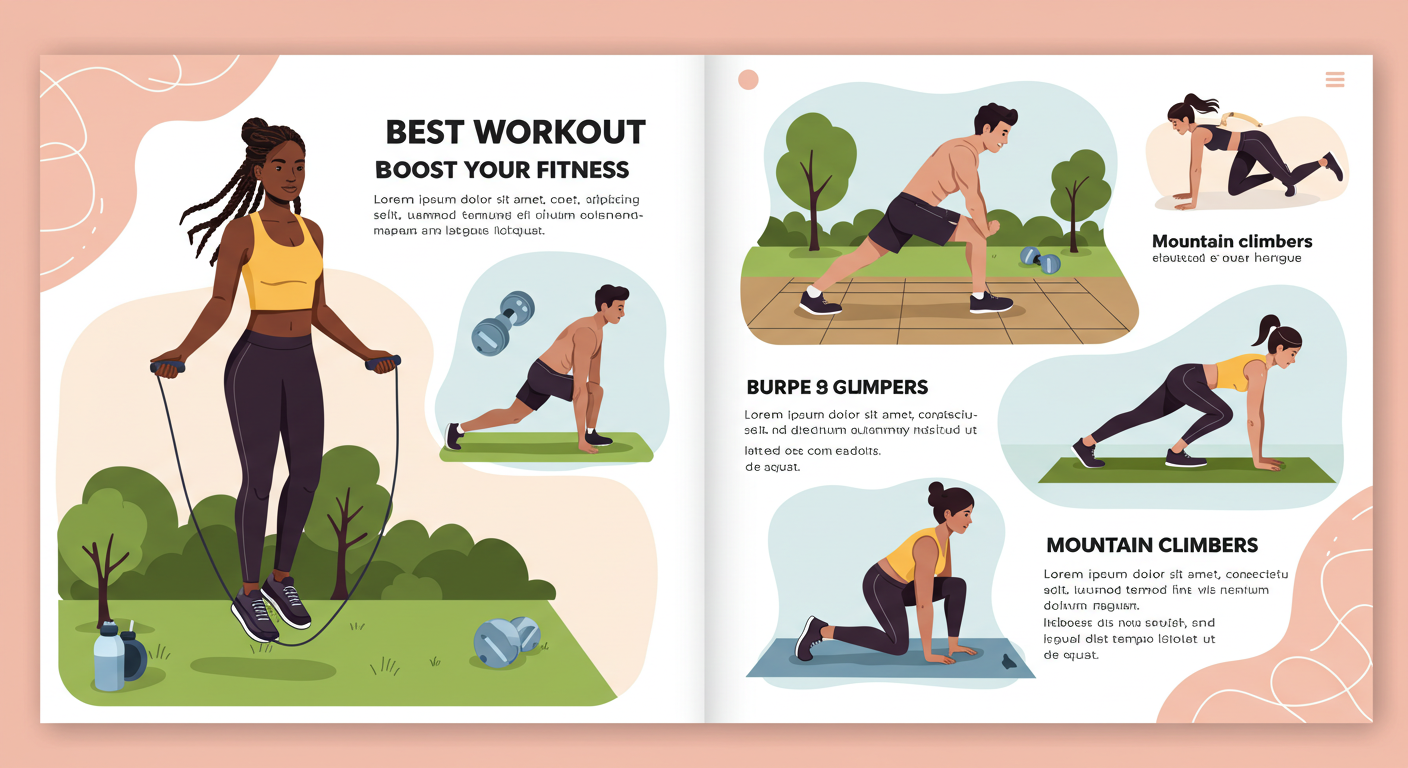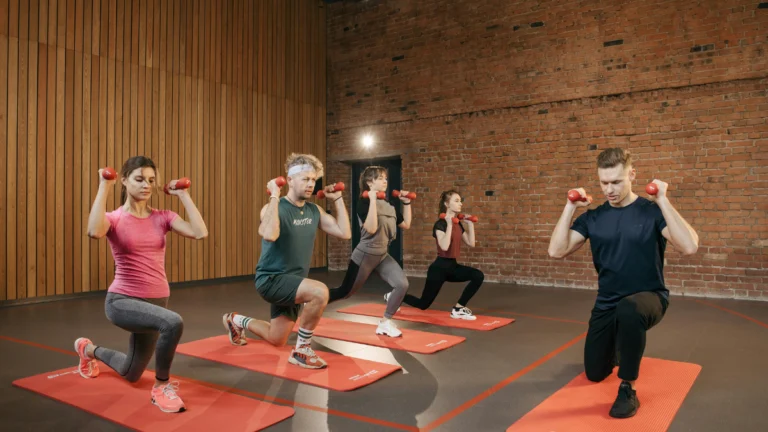Best Cardio Workouts to Boost Your Fitness

Ever feel like your fitness journey could use a little more joy and a lot less pressure? We’ve been there too. Whether you’re lacing up sneakers for the first time in months or looking to refresh your routine, finding the right activities to get your heart pumping doesn’t have to feel like a chore. That’s why we’re here—to walk this path with you, not just tell you what to do.
Movement is about more than burning calories or hitting a number on a tracker. It’s about feeling stronger, breathing deeper, and discovering what your body can do through the best cardio workouts. From dancing in your living room to swimming laps at the pool, every activity that raises your heart rate strengthens muscles and builds endurance. Even small efforts add up—like taking the stairs instead of the elevator or doing jumping jacks during TV commercials.
We’ve curated options for all energy levels and spaces. Love high-energy routines? Try interval training with burpees or jump rope drills. Prefer low-impact exercise? A brisk walk or cycling session works wonders. No gym membership? No problem. Many routines require just a few minutes and minimal equipment.
Key Takeaways
- Cardio activities improve heart health, stamina, and overall wellness.
- Workouts can be adapted for home, gym, or outdoor settings.
- Short sessions (even 10-15 minutes) create meaningful progress over time.
- Mix high-intensity and low-impact exercises to prevent burnout.
- Consistency matters more than perfection—every movement counts.
Table of Contents
- Understanding Cardio and Its Health Benefits
- Explore the Best Cardio Workouts for Every Fitness Level
- Low-Impact Cardio Options for Joint-Friendly Workouts
- High-Intensity Interval Training and Plyometric Movements
- Integrating Strength Training with Cardio Routines
- Cardio Workouts You Can Do at Home
- Planning Your Weekly Cardio Routine
- Conclusion
- FAQ
- How often should we do cardio each week?
- Can I build strength while improving cardiovascular fitness?
- What’s the difference between HIIT and steady-state cardio?
- Are there joint-friendly options if I have knee pain?
- How long should a home cardio session last?
- Can I use household items for cardio-strength combos?
- Why does my heart rate spike during burpees?
Understanding Cardio and Its Health Benefits
Ever wonder why your heart races during a brisk walk or dance session? Cardiovascular exercise, often considered a vital part of any cardio workout, refers to any activity that elevates your heart rate for sustained periods, improving oxygen delivery to muscles. Think of it as a partnership between your lungs, blood vessels, and heart—all working together to keep you moving.
What Is Cardiovascular Exercise?
These rhythmic movements—like cycling, swimming, or jumping rope—challenge your body’s ability to use oxygen efficiently. Whether you’re doing high-intensity intervals or steady-paced jogging, the goal is to strengthen your circulatory system over time.
The Impact on Heart Health and Endurance
Regular sessions—even 20-30 minutes three times a week—help your heart pump blood more effectively. This reduces strain on arteries and lowers resting heart rates. Over weeks, you’ll notice tasks like climbing stairs become easier as endurance builds.
Balancing intensity matters. For example, alternating between sprint intervals and moderate-paced walks allows recovery while maximizing gains. Studies show combining varied training styles supports long-term heart health better than repetitive routines.
“Consistency beats perfection. Ten minutes daily does more for longevity than occasional hour-long marathons.”
Start small. Swap one Netflix episode for a living room dance party or take phone calls while pacing. These tweaks add up, proving fitness isn’t about drastic changes—it’s about sustainable habits.
Explore the Best Cardio Workouts for Every Fitness Level
Looking for fresh ways to energize your routine without gym equipment? Let’s explore four adaptable activities that help you build strength while keeping things engaging. Whether you’re new to exercise or refining your fitness game, these options meet you where you are.
Jump Rope: Coordination Meets Efficiency
A 10-minute session burns as many calories as 30 minutes of jogging. Start with both feet together, swinging the rope from wrists—not shoulders. Beginners can try 30-second intervals with 15-second rests. Advanced athletes? Add crossovers or single-leg hops.
Burpees & Mountain Climbers: Full-Body Fire
These dynamic moves engage your arms, core, and legs simultaneously. Modify burpees by stepping back instead of jumping. For mountain climbers, slow the pace to focus on form. Aim for 3 sets of 12 reps, resting 45 seconds between sets.
| Exercise | Beginner | Advanced | Key Benefit |
|---|---|---|---|
| Jump Rope | 5-10 mins | 20+ mins | Improves coordination |
| Burpees | 8 reps | 15-20 reps | Builds explosive power |
| Mountain Climbers | 30 secs | 60-90 secs | Enhances core stability |
Running Smart: Warm-Ups & Progressions
Always start with a 5-minute brisk walk to prepare your body. New to jogging? Try the 1:1 method—run 1 minute, walk 1 minute. Seasoned runners can tackle hill repeats: sprint uphill for 20 seconds, recover for 2 minutes.
“Your feet should land softly, like you’re stepping on eggshells. It reduces joint impact by 30%.”
Cool down with calf stretches and hip circles. Remember—the best way to get heart benefits is consistency. Even three 15-minute sessions weekly make a difference over time.
Low-Impact Cardio Options for Joint-Friendly Workouts
Struggling to stay active without stressing your joints? We get it. High-impact movements aren’t the only path to a stronger heart—gentler alternatives can deliver results while keeping your knees and hips happy.
Pedal Your Way to Strength
Cycling tops our list for joint-friendly cardio exercises. Whether outdoors or on a stationary bike, 30-minute sessions at moderate pace burn 200-300 calories while building endurance. Start with flat terrain, gradually adding hills as your stamina improves. Experts recommend three 20-minute rides weekly to support heart health sustainably.
Water-Based Wellness
Swimming offers unmatched protection for sensitive joints. The water’s buoyancy reduces impact by 90%, letting you focus on smooth strokes. A 45-minute freestyle session torches 400+ calories while strengthening lung capacity. Try alternating laps with treading water to create a balanced workout plan.
“Low-impact doesn’t mean low results. These activities build cardiovascular resilience over time—crucial for long-term wellness.”
New to cardio exercise? Begin with 10-minute segments. Track progress using perceived exertion instead of speed. Remember—consistency in your workout plan matters more than intensity when nurturing your heart and joints.
High-Intensity Interval Training and Plyometric Movements

Ready to ignite your fitness routine with explosive energy? High-intensity interval training (HIIT) pairs short bursts of maximum effort with recovery phases, creating a powerful calorie burn while engaging multiple muscles. Best part? You can do it at home or the gym—no fancy gear required.
Squat Jumps & Jumping Jacks: Power Up Your Routine
Squat jumps fire up your glutes and quads while skyrocketing your heart rate. Start with feet shoulder-width apart, lower into a squat, then explode upward. Land softly, reset, and repeat. Beginners: aim for 3 sets of 10 reps with 45-second rests.
Jumping jacks add a cardio punch. Swing arms overhead as legs jump wide, then return. Try 30-second sprints followed by 15-second breaks. Modify by stepping side-to-side if needed.
HIIT Timing: Work Smarter, Not Harder
Effective intervals balance effort and recovery. A 1:2 ratio works well for starters—20 seconds all-out, 40 seconds rest. As your level improves, shift to 1:1 (30s work/30s rest). Sample routine:
| Exercise | Duration | Rest | Rounds |
|---|---|---|---|
| Squat Jumps | 20 sec | 40 sec | 5 |
| Jumping Jacks | 30 sec | 30 sec | 4 |
| Mountain Climbers | 25 sec | 35 sec | 6 |
“Push your pace during work intervals, but don’t sacrifice form. Quality reps protect joints and boost results.”
Adjust your rate of movement weekly. If 8 rounds feel manageable, reduce rest times by 5 seconds. Always cool down with dynamic stretches like leg swings or arm circles.
Integrating Strength Training with Cardio Routines
What if you could double your workout results without doubling gym time? Blending strength exercises with heart-pumping activity creates a powerhouse combination. This approach builds lean muscle while improving stamina—a win-win for long-term health and functional fitness.
Fuel Your Progress with Hybrid Sessions
Pairing resistance moves with high-intensity intervals challenges your body in new ways. Try adding dumbbell squats between sprint intervals on a stationary bike. Or mix push-ups with jumping jacks during home sessions. These combos boost calorie burn while strengthening bones and joints.
Focus on form first. For example, keep shoulders stable during overhead presses, and engage your core when lifting weight. Start with light resistance—even water bottles or bodyweight exercises work. Gradually increase difficulty as your plan evolves.
“Strength training isn’t just for bulking up. It’s the secret sauce for metabolic efficiency and injury prevention.”
Here’s a sample weekly plan:
| Day | Activity | Focus |
|---|---|---|
| Monday | Bike sprints + lunges | Lower body power |
| Wednesday | Swimming + resistance bands | Shoulder stability |
| Friday | Jump rope + push-ups | Full-body endurance |
Consistency transforms these hybrid sessions into habits. Even two 25-minute routines weekly strengthen your health foundation. Remember—every rep brings you closer to a balanced, resilient body.
Cardio Workouts You Can Do at Home

Need a fitness boost without leaving your living room? We’ve got you covered. Transform your space into a personal wellness studio with these adaptable activities—no bulky equipment or crowded gyms required.
Dancing: Rhythm Meets Cardio
Turn up your favorite playlist and let loose for 20 minutes. Freestyle dancing burns 150-200 calories while sharpening coordination. Not sure where to start? Try following along with online tutorials or mirroring dance-based exercise routine videos. Focus on keeping your heart rate elevated through continuous movement.
Rowing & Elliptical: Gym-Level Intensity at Home
Compact rowing machines offer full-body engagement—legs, core, and arms work in sync. Begin with 5-minute sessions at moderate pace, gradually increasing resistance. For elliptical workouts, mimic hill climbs by raising incline settings every 2 minutes. Both options build endurance while protecting joints.
“Home workouts thrive on creativity. Use water bottles as light weights or stair steps for modified drills.”
Build an effective exercise routine with this sample plan:
- Monday: 15-minute dance session + 3 sets of 25 jumping jacks
- Wednesday: 20-minute rowing intervals (30s sprint/1m recovery)
- Friday: 25-minute elliptical workout with alternating resistance levels
Track progress using a heart rate monitor or the talk test—if you can sing comfortably, increase intensity. Pair these sessions with bodyweight strength training like squats or planks for balanced results. Ready to redefine fitness on your terms? Your living room just became the ultimate wellness playground.
Planning Your Weekly Cardio Routine
Creating a sustainable weekly plan can feel overwhelming—but it doesn’t have to. We’re here to simplify the process. A balanced approach blends movement with rest, ensuring your cardiovascular system strengthens without burnout. Let’s break it down step by step.
Scheduling for Consistency and Recovery
Start by mapping out 3-5 days for activity. Alternate high-energy days (like HIIT sessions) with moderate ones (brisk walks or cycling). For example:
| Day | Focus | Activity |
|---|---|---|
| Monday | High Intensity | 20-minute sprint intervals |
| Wednesday | Moderate | 40-minute swim |
| Friday | Recovery | Yoga + leisurely walk |
Rest days are non-negotiable. They let muscles repair and your cardiovascular system adapt. Track progress with a journal or app—consistency builds habits.
Tailoring Duration and Intensity to Your Needs
Not everyone needs hour-long sessions. Begin with 15-20 minutes if you’re new. Gradually increase time before raising intensity. For example:
- Week 1: Three 15-minute walks
- Week 3: Two 25-minute HIIT sessions + one 30-minute bike ride
Adjust based on energy levels. Feeling drained? Swap a sprint day for yoga. Aim to burn calories efficiently by targeting different zones—steady pace for endurance, bursts for power.
“Listen to your body. If your legs or back ache, modify movements. Progress thrives on adaptability, not rigidity.”
Mix activities that engage your entire body—like rowing (works legs, back, and arms) or dancing (boosts coordination). This variety keeps your cardiovascular system challenged while preventing plateaus. Remember: Your plan should evolve as you do.
Conclusion
Your journey to better health isn’t about perfection—it’s about finding what moves you. From heart-pumping HIIT sessions to gentle swims, we’ve explored how varied activities improve heart health and build endurance. Remember how good it feels to conquer that final set of jumping jacks or finish a brisk walk? That’s your body thanking you.
Consistency trumps intensity. Whether you’re squeezing in 30 seconds of effort between meetings or dedicating mornings to a home routine, small actions create lasting change. Studies show mixing exercise styles—like pairing strength moves with cycling—yields better results than rigid plans.
Choose what fits your life. Love dancing? Crank up that playlist. Prefer quiet mornings? Try yoga flows. What matters is showing up, not chasing unrealistic standards. Every second of effort counts toward stronger lungs, happier joints, and a resilient heart.
We’re here cheering you on. Keep exploring, adjusting, and celebrating progress—your wellness journey is uniquely yours. Thank you for letting us walk this path with you. Ready for more tips? Join our community as we redefine health… one joyful movement at a time.
And to learn more about how to improve your life, check out other articles on TipsAndWellness.com
You can also search for more related content on Cnet.com
FAQ
How often should we do cardio each week?
We recommend aiming for 150 minutes of moderate-intensity activity weekly, like brisk walking or cycling. For high-intensity sessions like HIIT, 75 minutes weekly works well. Always balance with rest days to let muscles recover!
Can I build strength while improving cardiovascular fitness?
Absolutely! Combining resistance exercises like push-ups or dumbbell rows with interval training boosts both heart health and muscle tone. Try adding weighted squats between jump rope sets for a hybrid burn.
What’s the difference between HIIT and steady-state cardio?
HIIT alternates short bursts (like 30-second sprint intervals) with recovery periods, burning calories quickly. Steady-state (e.g., jogging) maintains one pace longer. Both benefit endurance – mix them based on your energy levels!
Are there joint-friendly options if I have knee pain?
Yes! Swimming, elliptical workouts, or cycling reduce impact while elevating your heart rate. Nike Training Club’s low-impact routines or Peloton’s seated rides are great modified choices.
How long should a home cardio session last?
Even 10-minute dance or rowing sessions count! We suggest starting with 20-minute home workouts (like FitnessBlender’s routines) and gradually increasing intensity. Consistency matters more than duration!
Can I use household items for cardio-strength combos?
Definitely! Fill water bottles as light weights during lunges, or step onto a sturdy chair for elevated mountain climbers. Creativity turns everyday objects into fitness tools!
Why does my heart rate spike during burpees?
Plyometric moves engage multiple muscle groups fast, demanding more oxygen. Track your pulse with a Fitbit or Apple Watch – staying at 70-85% max heart rate ensures safe, effective effort.
Discover more from Tips and Wellness
Subscribe to get the latest posts sent to your email.



